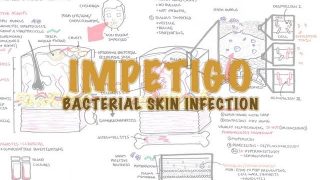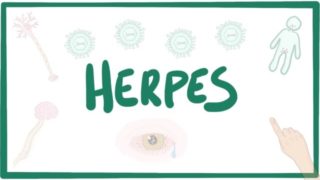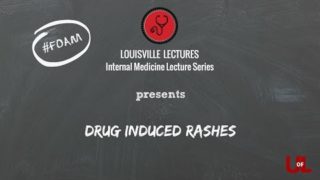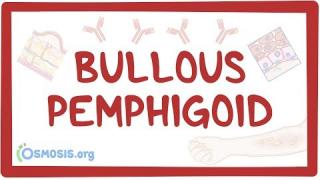Steven Johnson Syndrome (SJS), Toxic Epidermal Necrolysis (TEN) and Erythema multiforme for USMLE
Video handwritten lecture discussing Erythema Multiforme, Steven Johnson Syndrome (SJS) and Toxic Epidermolysis Necrosis (TEN) for the USMLE Step 1 and Step 2. We will be discussing the pathology, pathophysiology, causes and etiology, signs and symptoms, lab findings and management of this skin disorder.
ERYTHEMA MULTIFORME
Erythema multiforme is the mildest form of the epidermal necrolysis condition. Erythema Multiforme has a very characteristic target lesion that is very similar to urticarial. It is differentiated from erythema multiforme by the fact that urticarial disappears after 24 hours whereas erythema multiforme doesn’t.
Causes and etiology – Herpes, mycoplasma, drugs allergies may imitate erythema multiforme
History – Generally it is not preceded by Prodrome such as cough or sore throat, but they may have fever with a history of prior attacks.
Examination – normally found on face and extremities. Also exhibits the Koebner phenomenon. Sometimes the central area can blister. Mucocutaneous lesion may also be seen.
Course – usually last 2 weeka nd then there is resolution without sequelae, however recurrence is common.
Management – hospitalize if there is impaired feeding, may develop to SJS, and if there are constitutional symptoms.
EPIDERMAL NECROLYSIS
STEVEN JOHNSON SYNDROME (SJS)
Defined as involvement of less than 10percent of body surface area.
TOXIC EPIDERMYLOSIS NECROLYSIS (TEN)
Defined as involvement of more than 30 percent of body surface area.
CAUSES – High risk drugs – Sulfonamide, anti-convulsants, allopurinol, NSAIDs, NSAIDs usually taken 8 weeks prior. Also viral infections, immunizations, mycoplasma, GVHD.
Clinical – skin peels off for 5-7 days and plateaus for days to week and this is when there is sepsis and failure. Starts with prodromal symptoms such as fever, headaches, rhinitis. Cutaneous begins with face to upper trunk and then to upper limbs. Lesions starts as erythematous macules that then become confluent. These patients are Nikolsky’s sign positive meaning skin will rub off with minor pressure. Mucocuteneous lesions consists of pain on swallowing, eye pain. Extracutaneous symptoms related to pulmonary system (ARDS, Bronchiectasis), Esophageal to colon necrosis causing diarrhea, melena, malabsorption. Kidneys, nails, vulva, vagina involvement may also be present.
Prognosis scoring system is known as the SCORTEN. Age greater than 40, heart rate greater than 120, presence of cancer, BSA greater than 10 percent, urea greater than 20mmol, HCO3 greater than 20mmol and glucose greater than 14mmol. If more than 5 than 90 percent mortality.
Management – Oxygen and ABG. Check glucose, urea, and HCO3. First begin by stopping the drug which is causing the allergy. Admit to ICU or Burns wards and give fluids and electrolytes. If infection than give anti-biotics. Mouth rinse with anti-septic wash every day. Give emollients, anti-biotics and vitamin A for 24 hours. Medications such as corticosteroids, IVIG, cyclosporine A, plasmaphoresis and hemodialsis
Steven Johnson Syndrome (SJS), Toxic Epidermal Necrolysis (TEN) and Erythema multiforme for USMLE
Other Videos You Might Like:
Subscribe
Login
46 Comments
Newest




